Let's check up on Dokdo.Are you interested in Dokdo-related stories? Please click now.
01. Concerning the claim that the Japanese had already recognized the existence of Dokdo long ago Japan's claim
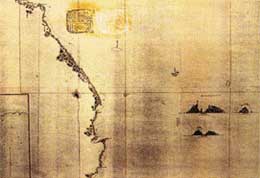
- "The Japanese recognized the existence Dokdo long ago. This is confirmed by our maps and literature, including Sekisui Nagakubo's Kaisei Nihon Yoch Rotei Zenzu (A Revised Route Map of Japan, which shows local fiefs and distances, 1779), the most representative Japanese map marked with longitude and latitude lines and other details."

Material 1 The Map of Joseon's East Coast (1876) made by the Ministry of Navy of Japan marks Dokdo as a part of Joseon.
- Kaisei Nihon Yoch Rotei Zenzu is a privately compiled map. On the original map made in 1779, Ulleungdo and Dokdo Islands are marked out of the longitude and latitude lines and, like mainland Joseon, they are not colored, showing that the Japanese viewed them as alien territory. Moreover, the Japanese government compiled maps like the Map of Joseon's East Coast (1876) made by the Ministry of Navy of Japan includes Dokdo within Korean territory.
- It appears that, after the Tokugawa Bakufu regime's 1696 prohibition of Japanese fishermen sailing to Ulleungdo Island, Japan's view of Ulleungdo and Dokdo Islands became unclear, and thus Japan came to call Dokdo by several different names including Matsushima, Liancourt Rocks, Lancourt, or Takeshima. Not only that, but didn't recognize where Dokdo is located.
02. Concerning the claim that Koreans had not recognized the existence of Dokdo long ago Japan's claim
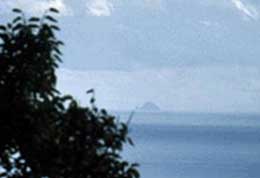
- "There is no basis for Koreans' recognition of the existence of Dokdo since long ago. There is no clear basis for Koreans' claim that Usando refers to Dokdo. Usando is another name for Ulleungdo Island or an imaginary island."

Material 2 Dokdo viewed from Ulleungdo Island: Dokdo is visible from Ulleungdo Island by the naked eye on a clear day.
- Dokdo is visible from Ulluengdo Island by the naked eye, which means that Dokdo was recognized by the inhabitants of Ulleungdo Island, including those who settled there long ago. Such recognition led to the island being clearly marked on many documents compiled by the Korean government, including Sejong Sillok Jiriji (1454), Sinjeung Donggukyeojiseungram (1530), Dongguk Munheon Bigo (1770), and Mangi Yoram (1808).
- Especially, Dongguk Munheon Bigo (1770) and Mangi Yoram (1808) among others clearly state that Ulleungdo and Usando Islands are both part of Usanguk's territory and that Usando is what the Japanese called Matsushima. These materials clearly show that Usando refers to Dokdo.
- The one-volume memorandum concerning the Korean boat that came onto Oki Island in the ninth year of Genroku, which is an investigative report associated with An Yongbok found in the Oki Islands , Japan in 2005, says that the map which An Yongbok took with him marked Ulleungdo and Dokdo as islands attached to Gangwon-do of Joseon. (Ref. Material 5 in the following)
- The primitive way of drawing up maps resulted in inaccurate representations of Dokdo's geographical location or size on ancient maps, which cannot be used as proof that Koreans did not recognize the existence of Dokdo. All olden-day maps of Korea, regardless of whether they were compiled privately or by the government, mark Ulleungdo and Dokdo very clearly.
03. Concerning the claim that the Japanese established dominium over Dokdo as early as the mid-seventeenth century Japan's claim
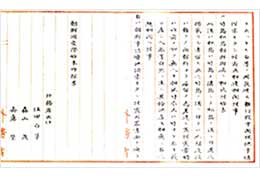
- "The Japanese used Dokdo as a port and as a fishing ground when they sailed to Ulleungdo Island. Japan established our dominium over Dokdo by the mid-seventeenth century at the latest." In 1618, during the early Edo Period, two families named Oya and Murakawa from Yonago in the Tottori Domain obtained a permit from the Bakufu to sail to Ulleungdo Island, where they enjoyed monopoly fishing rights and presented the abalones caught there to the Bakufu. They used Dokdo as an intermediate destination or place of anchorage for the voyage to Ulleungdo Island, and consequently as a place to hunt for sea lions and gather abalones."

Material 3 Chosenkok Kosaishimatsu Naitansho (Report on the Confidential Inquiry into the Particulars of Korean Foreign Relations/1870): Drawn up by the Foreign Ministry of Japan, this document states that Ulleungdo and Dokdo Islands belong to Joseon's territory.
- One does not generally need a permit to sail to an island in one's own country, which proves that the Japanese did not recognize Ulleungdo and Dokdo Islands as their territory.
- A record dating back to the mid-seventeenth century, Inshu Shicho Goki (Records of Observations of Inshu (1667), states that the Oki Islands marked the northwestern limit of Japan's territory, which means that the Japanese did not include Dokdo in their territory.
- In 1877, the Dajokan (Grand Council of State) of Japan said that, concerning the matter of Takeshima (Ulleungdo Island) and another island (Dokdo), it should be kept in mind that Japan had nothing to do with them, on the basis of the outcome of the talks held with Korea toward the end of the seventeenth century, thus recognizing that Dokdo was not Japan's territory.
- Meanwhile, the report titled Chosenkok Kosaishimatsu Naitansho (Report on the Confidential Inquiry into the Particulars of Korean Foreign Relations (1870), which was drawn up by the Foreign Ministry of Japan, concerns the situation about Takeshima (Ulleungdo Island) and Matsushima (Dokdo) attached to Joseon, which was self-clear about the status of Dokdo.
04. About the claim that Japan did not prohibit its people from sailing to Dokdo Japan's claim
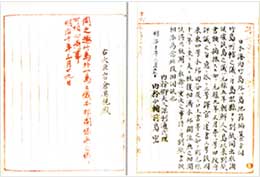
- "The Japanese Bakufu did prohibit Japanese people from sailing to Ulleungdo Island toward the end of the seventeenth century, but the prohibition did not include voyages to Dokdo, as a result of talks with Joseon concerning fishing right near Ulleungdo Island in 1696. It shows that they viewed Dokdo as their territory."

Material 4 The Dajokan's instruction(1877): The Dajokan (Grand Council of State of the Meiji Period) of Japan instructed the Interior Ministry that it should be kept in mind that Ulleungdo and Dokdo Islands had nothing to do with Japan based on the Bakufu's ban on sailing to Ulleungdo toward the end of the seventeenth century.
- When the Bakufu regime of Japan prohibited voyages to Ulleungdo Island towards the end of the seventeenth century, the Edo Bakufu asked, "Are there any islands belong to Tottori Domain other than Takeshima (Ulleungdo Island)?, to which Tottori Domain answered, "Neither Takeshima (Ulleungdo Island) nor Matsushim (Dokdo) belong to us. And no other islands belong to us.
- As stated in records like "Matsushima (Dokdo) within Takeshima (Ulleungdo Island)" or Matsushima near Takeshima" in documents kept at Oya Family of Japan, Dokdo was viewed as an island belonged to Ulleungdo Island. Thus, it was a matter of course that the order dating from January 1696 prohibiting the Japanese from sailing to Ulleungdo Island included the same prohibition to Dokdo.
- Japanese people's confusion about the name Dokdo in the period following the prohibition of voyages to Ulleungdo and Dokdo Islands suggests that they hardly recognized the existence of Dokdo.
05. Concerning what An Yongbok said to Japanese authorities Japan's claim
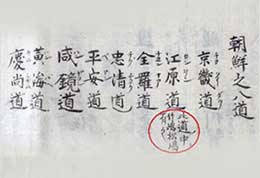
- "There are many questionable things in what An Yongbok said. They are only based on the Joseon government's claims. What he said is merely an exaggeration intended to mitigate his punishment for making an unauthorized voyage to Japan. And what he said does not correspond to the records kept in Japan."
- An Yongbok's activities in Japan were checked thoroughly by Joseon's Bibyeonsa (Border Defense Council), which makes it difficult to accept Japan's insistence that the official record is false.
-
Japan also asserts that what was officially recorded in Joseon is not right as such was not officially recorded in Japan. It is merely a one-sided view.
An Yongbok's activities in Japan are recorded in a number of Korean sources including Sukjong Sillok (The Veritable Record of the Reign of King Sukjong), Seungjeongwon Ilgi (Daily Records of the Royal Secretariat), and Dongguk Munheon Bigo (Reference Compilation of Documents on Korea), all of which are records officially compiled by the Joseon government; as well as in literature kept in Japan, such as Takeshima Kiji (Takeshima-related Articles), Excerpted memo concerning a Voyage to Takeshima, Ihonhokishi (異本伯耆志), Inpu Nenpyo (Special Chronicle of Inaba County), and Takeshima-Ko (Thoughts on Takeshima).

Material 5 Investigative Report on An Yongbok-related Case (1696): This document concerns the activities of An Yongbok on his second visit to Japan. It states that Takeshima (Ulleungdo Island) and Matsushima (Dokdo) belonged to Gangwon-do, Joseon.
-
An Yongbok's activities in Japan led to debates about Ulleungdo and Dokdo Islands in Japan, with the result Japan recognized them as parts of Joseon's territory.
After territorial sovereignty over the islands became a controversial issue due to An Yongbok's activities, in 1695 the Edo Bakufu asked when Ulleungdo and Dokdo Islands became part of the Tottori Domain, to which the reply was that "they did not belong the Tottori Domain." - The Bakufu's order of January 1696 not to sail to Ulleungdo Island was transmitted to the inhabitants of Yonago in August of the same year, which means they might have continued sailing to the island until that time. Thus, Japan's view that An Yongbok's statement about his encounter with Japanese people on the island in May of the same year was false is incorrect.
- The aforementioned one-volume memorandum concerning the Korean boat that came onto Oki Island in the ninth year of Genroku includes a reference to the names of the eight provinces of Joseon and Ulleungdo and Dokdo Islands which belonged to Gangwon-do, based on the map that AN Yongbok took with him on his visit to Japan. It clearly refers to the fact that at that time AN Yongbok said that Dokdo was a part of Joseon's territory.
06. Concerning the incorporation of Dokdo into Shimane Prefecture in 1905 Japan's claim
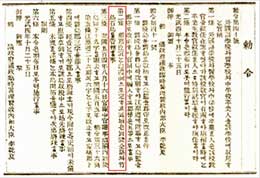
- In 1905, the Japanese government reconfirmed its intention to exercise its sovereignty over Dokdo by having it incorporated into Shimane Prefecture. In January 1905, the a meeting of the Japanese Cabinet accepted the petition for Dokdo's incorporation in Shimane Prefecture submitted by Yosaburo Nakai, an inhabitant of the Oki Islands in Shimane Prefecture. One month later, the governor of Shimane Prefecture put up a public notice to the effect that Dokdo had been brought under the jurisdiction of the Office of Oki Islands, which was also carried in various newspapers at that time. Then, the Japanese government registered Dokdo on the list of government-owned lands. It issued permits to hunt for sea lions on the island, and this status was maintained until the outbreak of World War II in 1941. It is highly unlikely that the Korean Empire Imperial Order No. 41 would have renamed Seokdo as "Dokdo" in 1900. Furthermore, even if any lingering doubts are dispelled, it is not true that Korea exercised effective control over Dokdo.
- If Dokdo had indeed been Japan's inherent territory as it continues to claim to this day, then why would it have needed to incorporate the island into its territory at as late a date as 1905? And why didn't it take similar steps for all its other inherent territories?
- It does not make any sense under international law to reconfirm one's intention to exercise sovereignty over one's own territory, and there has never been any such precedent. Japan's diplomatic and other documents dating from the 1950s and thereafter initially stated that its government's incorporation of Dokdo in 1905 as pre-occupation of terra nullius (a land belonging to no-one) and then changed it to "reconfirmation of the intention to exercise sovereignty." This change suggests us that Japan understood the flimsy nature of its basis.
-
Japan incorporated Dokdo in 1905 while it was in the process of stripping away Korea's sovereignty during the Russo-Japanese War. As such, it was an illegal and invalid attack on Korea's sovereignty over Dokdo, which had already been clearly established.
The Korean Empire (1897-1910) was exercising its sovereignty over Dokdo, as testified by the island's inclusion in the reorganization of its administrative districts in accordance with Imperial Order No. 41 (1900). Dokdo was not terra nullius in 1905 and thus Japan's incorporation of it into its own territory was clearly illegal under international law. Upon being informed of the steps taken by Japan, the Korean government reconfirmed the status of Dokdo as a part of the Korean territory (1906), but it was unable to lodge a diplomatic protest as Japan had deprived it of its diplomatic rights through the Second Korea-Japan Agreement, which Korea was coerced into signing in November 1905.

Material 6 Korean Empire Imperial Order No. 41 (1900) designates Seokdo (Dokdo) as an area under the jurisdiction of Ulleung-gun.
-
At first, Yosaburo Nakai intended to submit via the Japanese government a petition to the Korean government to lease Dokdo to him, as he knew that it was Korean territory. His subsequent change of mind and submittal of a petition for the incorporation of Dokdo into Japanese territory was the result of his being pressured or persuaded by officials of the Japanese Foreign Ministry and the Ministry of Navy, including Kaneyuki Kimotsuke and Enjiro Yamaza.
At that time, Inoue, an official of the Interior Ministry, was opposed to such a petition, saying, "Dokdo is a useless group of rocks and is thought to be a Korean territory. What's the good of incorporating it and attracting other countries' attention to what we are doing?" - Korean Empire Imperial Order No. 41 (1900) clearly testifies to Korea's effective control over Dokdo. The fact that "Seokdo" was used to refer to Dokdo is unquestionable, as the inhabitants of Ulleungdo Island called it Dokseom or Dolseom, which means the same as Seokdo (an island of rocks). As testified by Hong Jaehyeon, a member of one of the first groups of people to cultivate Ulleungdo Island in 1947, and as shown by the Dokdo bombing incident of 1948, the people of Ulleungdo Island continued to fish in the waters around Dokdo both before and after 1905.
07. Concerning the post-war measures of the Allied Powers Japan's claim

-
In the process of drawing up the draft of the Treaty of San Francisco, Korea asked the United States to include Dokdo among the territories to be relinquished by Japan. However, the US rejected this claim on the grounds that it was under the jurisdiction of Japan.
The fact that Dokdo was not included in the following clause of the Treaty of San Francisco (1951) - Japan, recognizing the independence of Korea, renounces all rights, titles and claims to Korea" - is evident even in relevant documents disclosed by the United States.
- Initially, the United States recognized Dokdo as Korean territory, and only changed its attitude due to Japan's lobbying.
- Japan rejects the clause in the Treaty of San Francisco that recognizes the Kuril Islands (Northern Territories) as Russian territory, but insists that Dokdo is its territory although the said treaty does not contain a clause about it. Such an attitude lacks logical consistency.
-
With regard to Dokdo, the General Headquarters Supreme Commander for the Allied Powers (GHQ SCAP) consistently applied SCAPIN-677 throughtout its occupation of Japan without issuing any other order. Immediately after the signing of the Treaty of San Francisco, the Japanese government confirmed the exclusion of Dokdo from the areas subject to Japan's jurisdiction.
In October 1951, the Japanese government submitted the Japan's Domain Map, which was drawn up based on the Treaty of San Francisco, to the the House of Representatives of its Diet. The map clearly marks Dokdo as Korean territory.

Material 7 Japan's Domain Map ["The Treaty of San Francisco" (carried in the Mainichi Shimbun, 1952)]: This map shows the fact that, right after the signing of the Treaty of San Francisco, even the Japanese government confirmed the exclusion of Dokdo from the areas subject to Japan's jurisdiction.
-
SCAPIN-677 defined Dokdo, along with Ulleungdo Island, as an area not included under Japan's jurisdiction.
SCAPIN-677: 3. SCAPIN-677, Article 3. "For the purpose of this directive, Japan is defined to include the four main islands of Japan (Hokkaido, Honshu, Kyushu, and Shikoku) and the approximately 1,000 smaller adjacent islands…… and excludes (a) Utsuryo (Ullung) Island, Liancourt Rocks and Quelpart Island….." - The Allied Powers' separation of Dokdo from Japan between the end of World War II and the signing of the Treaty of San Francisco was the embodiment of the policy for handling the post-war situation established through the 1943 Cairo Declaration and the 1945 Potsdam Declaration. In other words, Dokdo was a Korean territory that had been plundered by Japan through violence and avarice during the Russo-Japanese War, which was a war of plunder waged against other sovereign territories, and thus it naturally had to be returned to its rightful owner.
- Dokdo, like other parts of Korea, was put under the control of the U.S. military at the end of the war after being separated from Japan, as decided by the Allied Powers, and was returned to Korea, along with other Korean islands, upon the establishment of the Republic of Korea government on August 15, 1948 in accordance with the UN resolution. As such, the Treaty of San Francisco merely confirmed this.
08. Concerning measures taken by the Allied Powers after the war Japan's claim
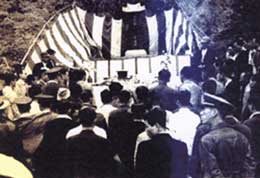
-
Dokdo was designated as a bombing range of the US Forces in Japan 1952. It is clear that the island was handled as a Japanese territory.
The US Forces in Japan designated Dokdo Islands as one of its bombing ranges based on the U.S.-Japan Administrative Agreement/1952 and notified the Japanese Foreign Ministry thereof."
- Following a protest from the Korean government, the US Air Force excluded Dokdo from its bombing ranges and officially notified Korea of the matter.

Material 8 The ceremony for the unveiling of the memorial monument to the fishermen killed in Dokdo (June 8, 1950): The ceremony was being held in Dokdo with the Governor of Gyeongsangbuk-do in attendance for the Korean fishermen killed by the US bombing of Dokdo in 1948,
- The fact that Dokdo was included within the KADIZ (Korean Air Defense Identification Zone) designated around that time and without the JADIZ shows that such was a measure taken based on the knowledge that Dokdo was a Korean territory.
-
Statements made at sessions of the Japanese Diet suggest that the designation of Dokdo as one of the US Air Force's bombing ranges and its continued bombing training there in 1952 was the result of Japan's coaxing. Such an act resulted in the loss of the lives of Korean fishermen based on or near Dokdo.
Yamamoto: "With regard to the designation of bombing ranges for the US Forces in Japan, please tell us whether the Foreign Ministry would like the US Forces to designate Dokdo as one of the ranges based on the idea that this might make it easier to have the United States confirm Japan's sovereignty over the island."
Ishihara: "I think that the matter is being promoted in diverse respects based on such thinking."
09. Concerning Korea's effective control of Dokdo Japan's claim
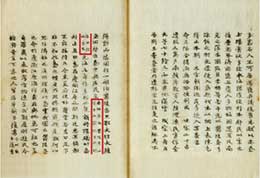
- "Korea occupies Dokdo illegally and Japan is protesting about it stringently. Korea's illegal occupation of Dokdo is groundless under international law. No acts committed by Korea on or about Dokdo can be legally justified."

Material 9 Mangi Yoram (1808) states that Ulleungdo Island and Usando Island (Dokdo) are parts of Usanguk's territory.
- Japan has never established its legal sovereignty over Dokdo at any time in its history. Japan's claim to the island is nothing more than a unilateral and illegal act that infringes on the Republic of Korea's territorial sovereignty.
-
Japan attempted to secure its sovereignty over Dokdo in 1905, but Korea had long since established its sovereignty over the island.
The following documents clearly state that Dokdo is a Korean territory: Sejong Sillok Jiriji(1545), Mangi Yoram(1808), and Korean Empire Imperial Order No. 41(1900), each of which was issued by the Korean government; the Edo Bakufu's official letter prohibiting Japanese people from sailing to Ulleungdo Island (1696), the Meiji government's Chosenkok Kosaishimatsu Naitansho(1870), and the Dajokan's order(1877), each of which were issued by the Japanese government; and SCAPIN-677 and 1033 (1946), which were made by the GHQ SCAP.
10. Concerning the proposal for referral of the matter to the International Court of Justice (ICJ) Japan's claim

- Korea refuses to accept our proposal for referral of the matter concerning sovereignty over Dokdo Isalnd to the ICJ. The Japanese government proposed the referral of the matter to the ICJ in September 1954 and again in March 1962, but the Republic of Korea refused to accept it.

Material 10 Dokdo, the touchstone of future relations between Korea and Japan
- Japan refuses to accept the referral of the matter concerning sovereignty over the Diaoyudao (Senkaku Islands) or Kuril Islands (Northern Territories) to the ICJ, but asks Korea to refer the matter concerning Dokdo to the same, which is a somewhat contradictory position.
- Dokdo is a part of the Korean territory over which Korea regained control after the Japanese imperialists' forceful incorporation of it. There is no doubt that Dokdo is a part of the Republic of Korea's territory and thus the Republic of Korea sees no reason whatsoever to refer it to a court. The only desirable solution to the matter is for Japan to abandon its claim to the island which is associated with its past acts of aggression and invasion.

